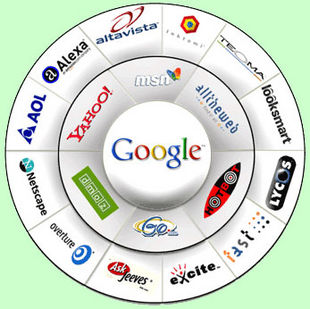
The term “search engine” is often used generically to describe crawler-based search engines, human-powered directories, and hybrid search engines. These types of search engines gather their listings in different ways, through
- crawler-based searches
- human-powered directories
- hybrid searches
1. Crawler-based search engines
Crawler-based search engines, such as Google (http://www.google.com), create their listings automatically. They “crawl” or “spider” the web, then people search through what they have found. If web pages are changed, crawler-based search engines eventually find these changes, and that can affect how those pages are listed. Page titles, body copy and other elements all play a role.
The life span of a typical web query normally lasts less than half a second, yet involves a number of different steps that must be completed before results can be delivered to a person seeking information. The following graphic (Figure 1) illustrates this life span (from http://www.google.com/corporate/tech.html):
- The web server sends the query to the index servers. The content inside the index servers is similar to the index in the back of a book – it tells which pages contain the words that match the query.
- The query travels to the doc servers, which actually retrieve the stored documents. Snippets are generated to describe each search result.
- The search results are returned to the user in a fraction of a second.
2. Human-powered directories
A human-powered directory, such as the Open Directory Project (http://www.dmoz.org/about.html) depends on humans for its listings. (Yahoo!, which used to be a directory, now gets its information from the use of crawlers.) A directory gets its information from submissions, which include a short description to the directory for the entire site, or from editors who write one for sites they review. A search looks for matches only in the descriptions submitted. Changing web pages, therefore, has no effect on how they are listed. Techniques that are useful for improving a listing with a search engine have nothing to do with improving a listing in a directory. The only exception is that a good site, with good content, might be more likely to get reviewed for free than a poor site.
3. Hybrid search engines
Today, it is extremely common for crawler-type and human-powered results to be combined when conducting a search. Usually, a hybrid search engine will favor one type of listings over another.
Hybrid Search Engines – A Review
No business can ignore the popularity of social network site such as Facebook and Twitter. Millions of potential customers, ready to listen and pay attention. The same could also be said about the power of the SEO, allowing business web pages be found instantly, through key word searches. As a general rule the two rarely are given the opportunity to mix- if customers wants to search for a site they will Google it and if a user wants to get in touch with their friends they will log on to Facebook. But there are options to have the best of both worlds…
Networking sites can revolve around any topic matter, from the very bizzare to the most useful. Fans of web surfing can join social networking groups that review sites that they discovered them selves through random browsing. There is more emphasis placed on searching, reviewing and sharing sites than displaying a personal profile. First used as a way to fill boredom, its now a growing trend and more effective in its searches. StumbleUpon is perhaps the most well known and effective in this
StumbleUpon
First asking a new user to describe their interests and hobbies it will then place a one click search button on the tool bar. Using a recommender system, it will return sites that others have reviewed and believe that you will enjoy. It can even be used along side larger search engines such as Google, giving an approved tick for sites that it has specifically matched you with. StumbleUpon’s success can be attributed to its user friendly interface. Clicking a thumbs up or down to show what the user thinks of a particular site is all that needs to be done. If it is a site that has never been reviewed before the user is congratulated on finding the site and given the option to write a full review for other members.
Yoono
Yoono is a social media tool that is more of a add on to the Firefox browser. It sits in your side bar giving you feeds of your friends activities on Twitter and Facebook. With Yoono there is a selection of various widgets that give you different search options. The most useful of these is the ‘Discover’ button which takes you to sites that are similar to the one being viewed at that time. Yoono differs from StumbleUpon with a ’surprise’ button, scanning bookmarks already saved and taking you to a random site that is related.
Fichey
Fichey is perhaps most unique of the social network searches. Taking popular searches from Digg, StumbleUpon and other similar sites it compiles searches and turns the sites into pages that can be ‘flipped’ like a magazine. Another unique feature found on Fichey is that searches can be specified to show site pages published on a particular day.
Although these site are still relatively new, they are growing fast in popularity making it prime ground for businesses to get noticed and bring themselves closer to their customers.



























What about Bing?
Bing is crawler based. With the new AI (ChatGPT) the automated crawler search engines may all have AI embedded.
Bing?
[…] three types of search engines are crawler-based searches [1][2], human-powered directories, and hybrid searches. Crawler-based searches use a […]